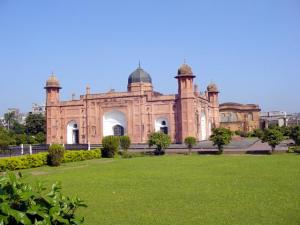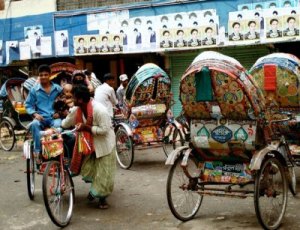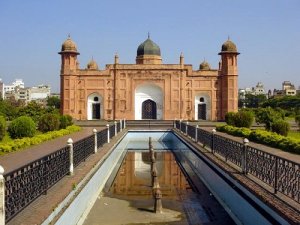Dhaka, with it’s greater metropolitan area, is the 9th largest city in the world, with a population of over 16 million. This place is the king of the rickshaw, with over 400 thousand trading throughout the city. Although the city dates back to the Mughal rule of the 17th century, there are settlements that take it further to around the 7th.
The sheer amount of people and traffic is almost overwhelming. On my way into the city, I felt I was dicing with death on every turn, and a few cyclists bumped off the van as they bustled through. They don’t even seem to pay much attention to the traffic lights either, which a strung up high.
I took a short walk last night to look around the area the hotel is in. Around the corner I walked towards the junction on Rommna road and Kazi Nazrul Islam Avenue and the park that held the Shika Chiranton. This is where, in December 1970, the Pakistan army surrendered and the Bangladesh nation was born. This date was the culmination of nine months of bloody battle and the arrest, torture and murder of thousands of people in what was the war of independence. East Pakistan became Bangladesh.
 |
Dhaka rose up during the Mughal empire. During their reign, and the rulers since, impressive monuments of all kinds were built. Dhaka is known as the city of Mosques, but some of the earlier buildings stand out. Aurangabad Fort, or Lalbagh fort, as it is commonly known, is one of them. Located in the old city, it overlooks the Buriganga on the northern bank where is stands.
I am constantly watched and approached. Beggars follow me, a girl tries to sell me dodgy looking water in an Evian bottle. Another with a handful of sad flowers. Most are simply after money. There is rubbish along the side of most roads and the sewage is open. There’s plenty to smell and see, and it is humbling to think that we live in such well managed cities in the west. It makes you wonder what the Governments think of here. Walking at night is probably not a good thing to do, and I headed back to the hotel, had something to eat and retired to my room.
This morning I am up early again to head north east, but I take the N1 out and N102 north. As I cross the Meghna river, which is to the east of the city, I see the Magna Power station. The official name of the highway bridge I cross is Japan Bangladesh Friendship Bridge, but it is popularly known as Meghna Bridge and was opened in 1991. The river seems to split in every direction and the land is so low I can see how the water spreads out so easily during the monsoon season.



